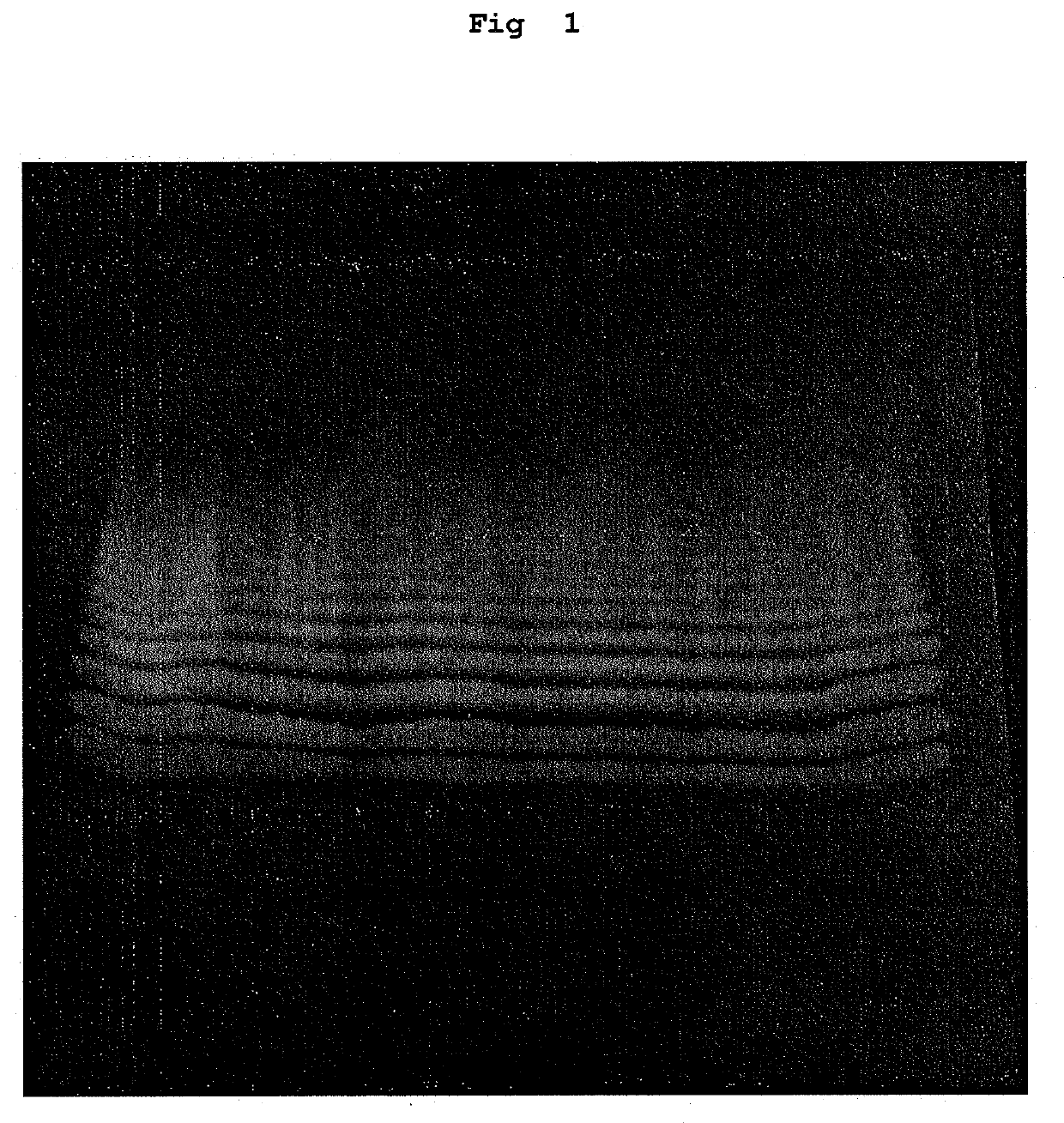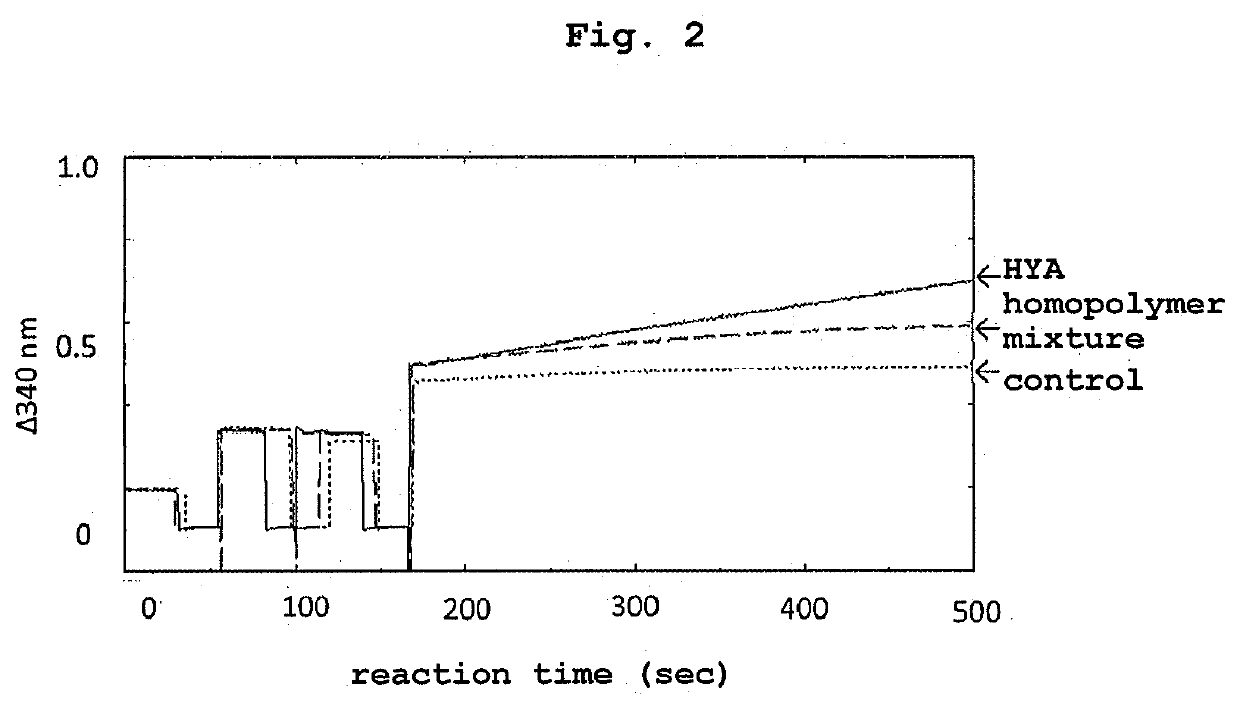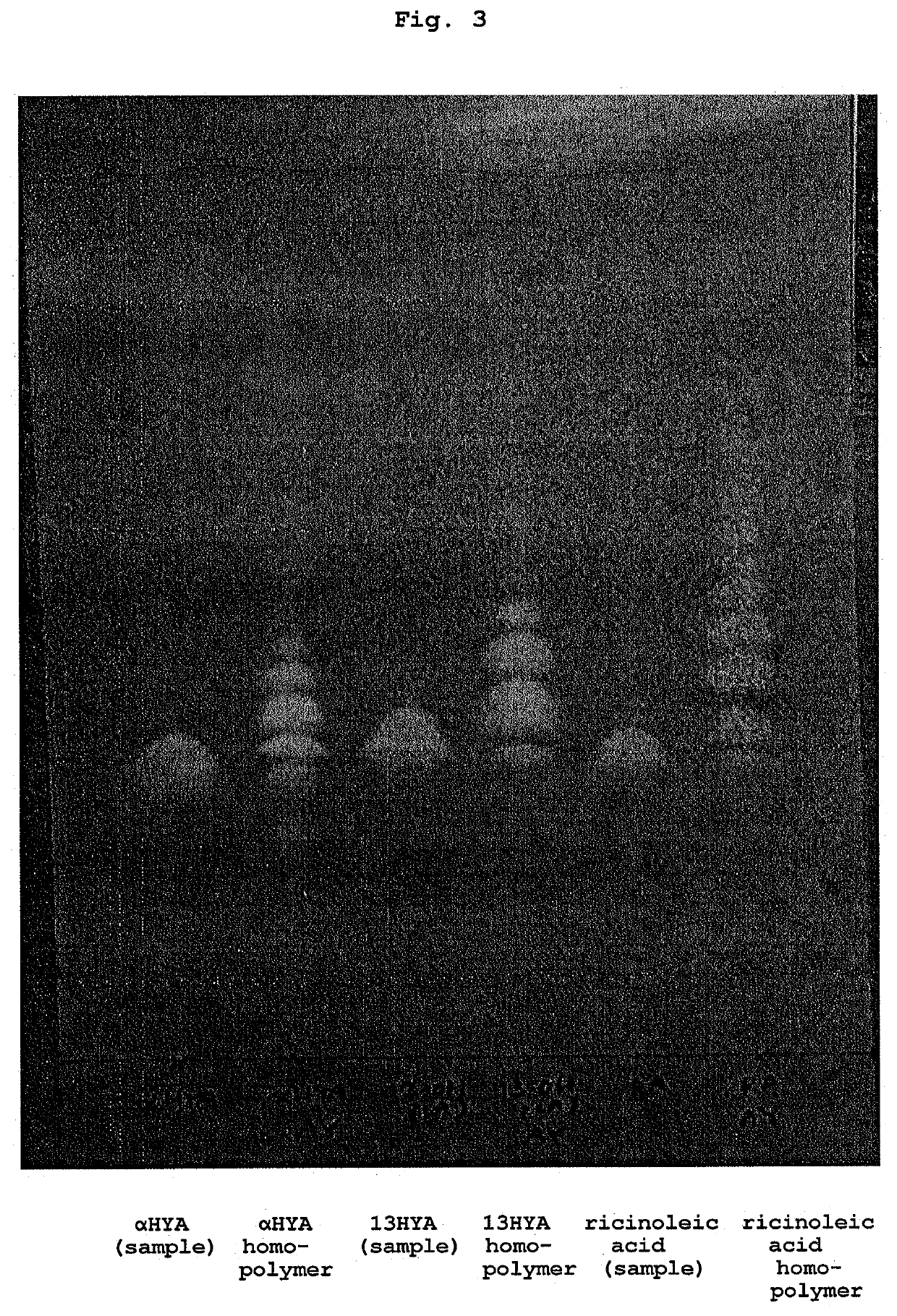Hydroxylated fatty acid homopolymer and production method thereof
a technology of hydroxylated fatty acid and homopolymer, which is applied in the field of new hydroxylated fatty acid homopolymer, can solve the problems of insufficient analysis of the physiological functions of hya-derived molecules, inability to add or mix with other liquid or solid food components, and inability to meet the needs of use, etc., and achieves the effect of convenient handling of substances and useful to stabilize the properties of hya-derived molecules
- Summary
- Abstract
- Description
- Claims
- Application Information
AI Technical Summary
Benefits of technology
Problems solved by technology
Method used
Image
Examples
example 1
[0186]MilliQ water (0.3 mL) was added to 10-hydroxy-cis-12-octadecenoic acid (184 mg) and the mixture was sonicated for 20 sec. Lipase AY “Amano” 30SD (11 mg) was added and the mixture was reacted by stirring at 37° C., 130 rpm for 24 hr. The liquid after the reaction was extracted by the Bligh-Dyer method, and isolated and purified by silica gel chromatography (eluent hexane:diethyl ether:acetic acid=40:60:1) to give a dimer of HYA (9.4 mg), a trimer of HYA (4.7 mg), and a tetramer of HYA (7.9 mg).
dimer of HYA
Rf value=0.30 by silica gel chromatography (eluent
hexane:diethyl ether:acetic acid=40:60:1)
[0187]1H NMR (CDCl3, 400 MHz): (δ) ppm: 0.89 (t, 6H, J=6.8 Hz), 1.29 (m, 32H), 1.59 (m, 8H), 2.02 (dt, 2H, J=6.2, 7.0 Hz), 2.05 (dt, 2H, J=6.7, 6.9 Hz), 2.22 (dd, 2H, J=7.1, 7.1 Hz), 2.27 (dd, 2H, J=7.3, 7.3 Hz), 2.33 (t, 4H, J=7.5 Hz), 3.64 (tt, 1H, J=5.9, 6.2 Hz), 4.89 (tt, 1H, J=5.9, 6.3 Hz), 5.32 (dt, 1H, J=10.9, 7.3 Hz), 5.39 (dt, 1H, J=11.0, 5.9 Hz), 5.48 (dt, 1H, J=10.9, 7.2 Hz), ...
example 2
[0194]MilliQ water (0.3 mL) was added to 10-hydroxy-cis-12-octadecenoic acid (184 mg) and the mixture was sonicated for 20 sec. Thereafter, lipase AY “Amano” 30SD (11 mg) was added and the mixture was reacted by stirring at 37° C., 130 rpm for 24 hr. The fats and oils component alone was extracted from the reaction solution by the Bligh-Dyer method and concentrated by an evaporator. The resulting solution was applied to thin layer chromatography (TLC Silica gel 60 F254; eluent hexane:diethyl ether:acetic acid=40:60:1). The results of thin layer chromatography (365 nm UV radiation) are shown in FIG. 1.
[0195]From FIG. 1, the spots where HYAs were polymerized could be confirmed. From the number of spots, it could be confirmed that HYAs became a dimer to a decamer.
[0196]The Rf value of each spot is as follows.
dimer of HYA: 0.30
trimer of HYA: 0.38
tetramer of HYA: 0.42
pentamer of HYA: 0.46
hexamer of HYA: 0.49
heptamer of HYA: 0.52
octamer of HYAr: 0.55
nonamer of HYA: 0.56
decamer of HYA: 0.5...
example 3
[0197]The oxidation stability was compared between the reaction extract (homopolymer mixture) obtained in Example 1 and HYA. The oxidation reaction was performed using NAD+ as an electron receptor in the presence of hydroxylated fatty acid dehydrogenase (CLA-DH) (S. Kishino et al., Polyunsaturated fatty acid saturation by gut lactic acid bacteria affecting host lipid composition. Proc. Natl. Acad. Sci. USA, 110(44), 17808-17813, 2013).
[0198]The reaction mixture (3 mL) contained CLA-DH-expressing Escherichia coli cell-free extract (150 μL, derived from 50 mg Escherichia coli wet cells) as hydroxylated fatty acid dehydrogenase, 4 mM NAD+, 150 μL of ethanol, and 0.48 mM (0.143 mg / mL) HYA or equal amount (0.143 mg / mL) of a homopolymer mixture as a substrate, and the reaction was started by the addition of hydroxylated fatty acid dehydrogenase and performed at 37° C. for about 6 min. The control did not contain a substrate. The progress of oxidation was quantified by measuring the change...
PUM
 Login to View More
Login to View More Abstract
Description
Claims
Application Information
 Login to View More
Login to View More - R&D
- Intellectual Property
- Life Sciences
- Materials
- Tech Scout
- Unparalleled Data Quality
- Higher Quality Content
- 60% Fewer Hallucinations
Browse by: Latest US Patents, China's latest patents, Technical Efficacy Thesaurus, Application Domain, Technology Topic, Popular Technical Reports.
© 2025 PatSnap. All rights reserved.Legal|Privacy policy|Modern Slavery Act Transparency Statement|Sitemap|About US| Contact US: help@patsnap.com



